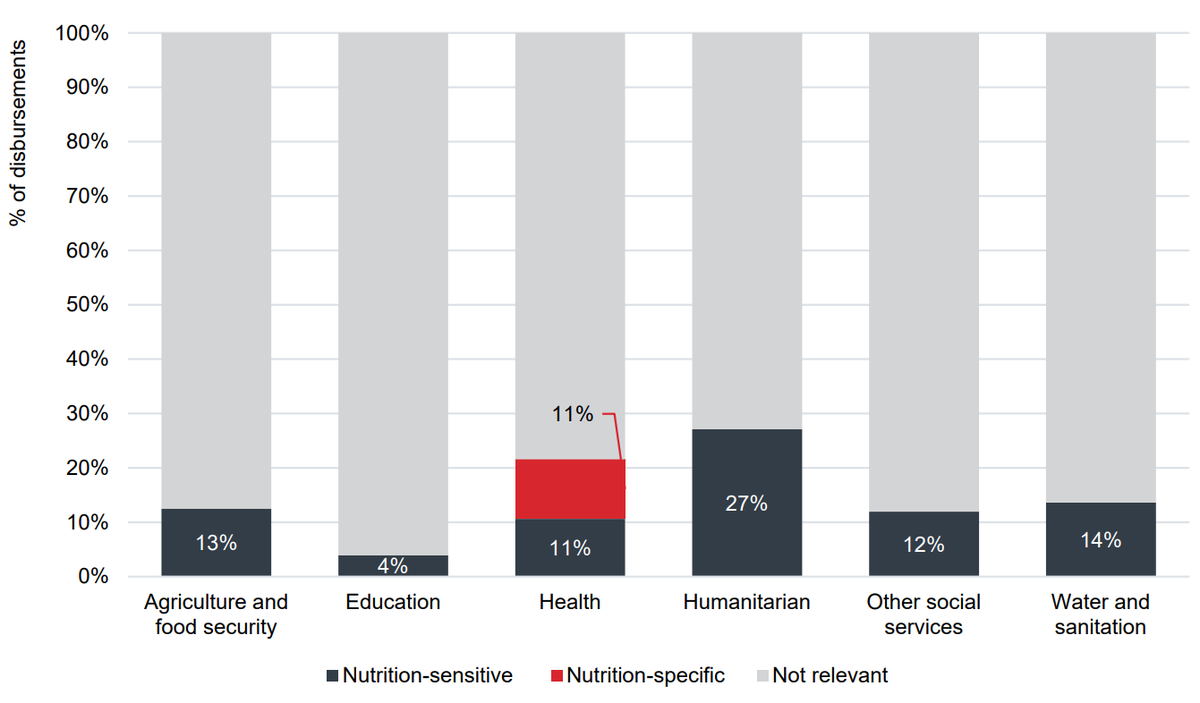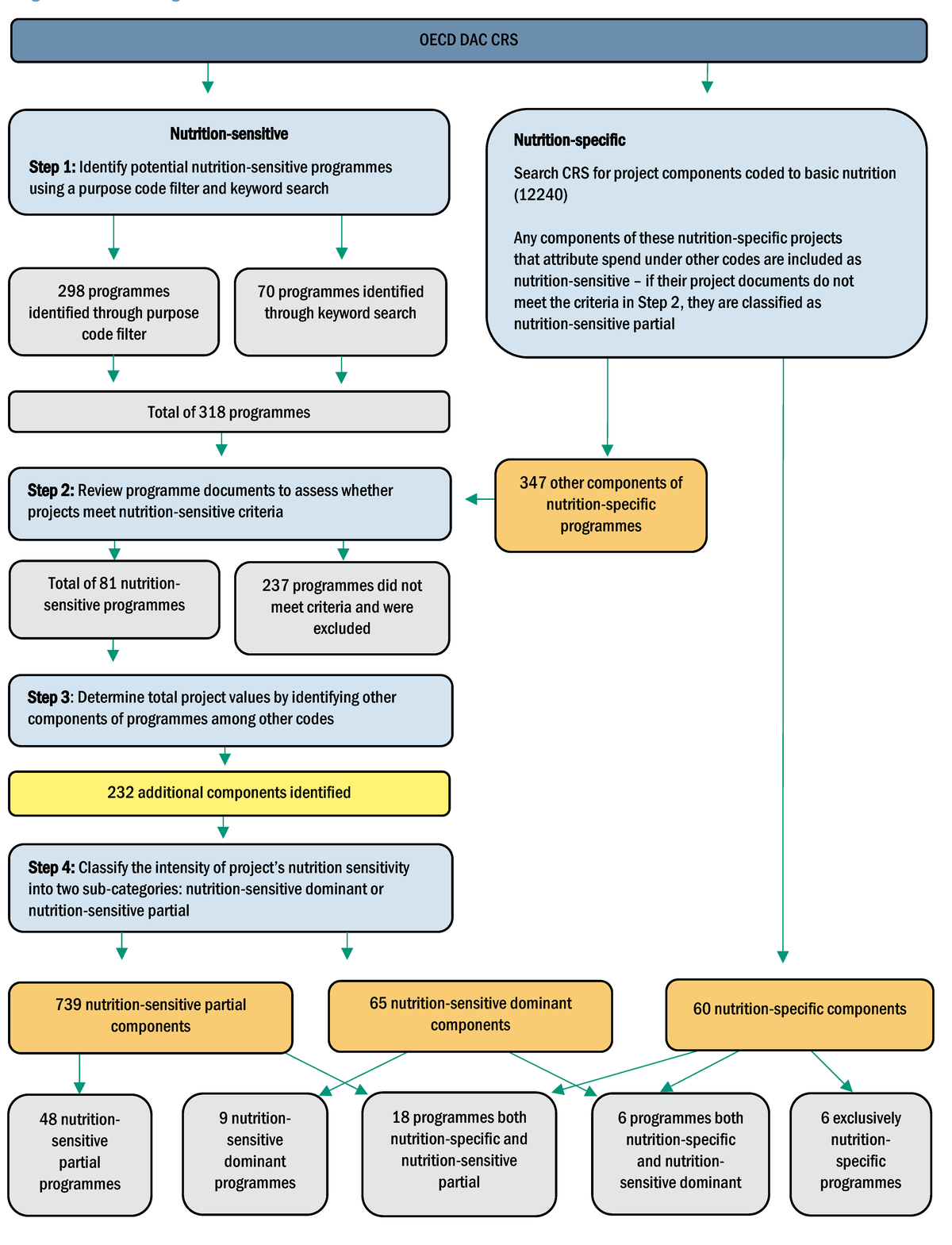FCDO’s aid spending for nutrition: 2021
The latest data on the UK Foreign, Commonwealth & Development Office (FCDO)’s aid spending to improve nutrition, with breakdowns by country recipient and sector.
DownloadsA note on the data in this paper:
This was report was updated in June 2024 to correct an error affecting the published value for FCDO’s total aid spending for nutrition as a proportion of its total ODA spending in 2020. This was originally reported as 8.5% for 2020. The correct value is 12.8%.
Submitted by DAI in association with:

Read more about DI's work in the Technical Assistance to Strengthen Capabilities (TASC) project .
Executive summary
Despite some progress towards achieving global maternal, infant and young child nutrition targets (WHO, 2014), unacceptable levels of malnutrition persist throughout the world (GNR, 2021). The financial costs required to meet nutrition targets have also grown significantly, partly due to the impact of Covid-19.
Official development assistance (ODA, commonly known as aid) [1] is a crucial resource for addressing malnutrition and achieving short-, medium-, and long-term nutrition outcomes in developing countries. At the 2021 Tokyo Nutrition for Growth (N4G) Summit, the UK made new financial commitments, continuing on from the commitments made at the 2013 London N4G Summit.
In 2021, the UK committed to
- integrate nutrition objectives across its programme portfolio (including in sectors such as health, humanitarian, women and girls, and climate),
- to adopt the Organisation for Economic Co-operation and Development (OECD) Development Assistance Committee (DAC) Nutrition Policy Marker at programme-design stage,
- and to spend £1.5 billion on nutrition programmes between 2022 and 2030.
These commitments were prepared in the context of the UK 2021 reduction in ODA spending from 0.7% to 0.5% of GNI, when the government cited economic challenges posed by the Covid-19 pandemic. This reduction in the government’s annual ODA budget has remained in place, and the return to ODA spending at 0.7% of GNI depends on the UK meeting two fiscal conditions. [2]
Against this backdrop, this report presents detailed information on the UK’s Foreign, Commonwealth & Development Office (FCDO) bilateral aid spending to improve nutrition. Building on previous assessments (published by Development Initiatives each year since 2014) and using the Scaling Up Nutrition (SUN) Donor Network’s (SDN) agreed methodology, the report analyses the latest available data (up to 2021), alongside historical data, and finds:
-
In 2021, FCDO’s total bilateral aid spending for nutrition decreased by 61.3% to US$441.6 million.
- Spending on nutrition-specific programmes [3] decreased by 57.3%, from US$122.1 million in 2020 to US$52.2 million in 2021, the lowest amount since 2011 and largely the result of fewer disbursements to existing nutrition-specific programmes.
- Spending on nutrition-sensitive programmes [4] decreased by 61.8%, from US$1,018.6 million in 2020 to US$389.4 million in 2021, the lowest amount since 2012, and largely the result of fewer disbursements to existing nutrition-sensitive programmes.
- Relative to its total bilateral ODA spending, FCDO’s total nutrition spending decreased to 7.0% from a peak of 12.8% in 2020, the lowest proportion since 2012.
-
The total number of nutrition-related programmes supported by FCDO decreased for the third consecutive year, by 14 to 86 programmes, which is the lowest number in the period 2010–2021.
- This portfolio included five nutrition-specific programmes, 57 nutrition-sensitive programmes and 24 programmes with both nutrition-specific and nutrition-sensitive components.
- The mean annual amount FCDO spent on a nutrition-related programme in 2021 was US$5.1 million.
-
In 2021, nutrition-sensitive spending across sectors decreased.
- Although nutrition-sensitive spending to humanitarian programmes reduced (down to US$264.8 million), this sector received 68% of FCDO’s nutrition-sensitive spending, which was a greater proportion than 2020.
- Total spend decreased in all sectors except the environment sector, which had a slight increase in nutrition-sensitive spending (US$7.1 million in 2020 to US$8.2 million in 2021).
-
Nutrition spending to all regions decreased, but the majority of FCDO’s nutrition spending remains in sub-Saharan Africa.
- While spending to Yemen decreased, it remained the greatest single recipient of FCDO’s nutrition ODA in 2021, for the fourth consecutive year.
- Spending increased in three countries and decreased in thirty.
- The mean annual amount of nutrition-related ODA received by any country decreased from US$31.7 million in 2020 to US$12.9 million in 2021.
- 78% of FCDO’s nutrition-related spending had gender policy objectives in 2021, which is a small decrease compared to 2020 (79%).
- In 2021, 5% of FCDO’s International Climate Financing also contained nutrition objectives, a small decrease compared to 2020 (6%).
Introduction
The Department for International Development (DFID) merged with the Foreign & Commonwealth Office on 2 September 2020 to become the Foreign, Commonwealth & Development Office (FCDO). This document covers commitments and disbursements made by FCDO (and DFID, prior to the merger).
This report identifies and analyses the UK FCDO’s bilateral official development assistance (ODA) spending on nutrition-related projects. The analysis uses the methodology developed by the Scaling Up Nutrition (SUN) Donor Network (SDN) [5] with the aim of capturing such spending in order to better track resources for nutrition. This methodology is adopted here to capture FCDO’s nutrition spend in 2021, and for monitoring nutrition spend over time, capturing the period 2010–2021.
Previous iterations of this report have tracked progress against nutrition spending targets committed by DFID at the 2013 Nutrition for Growth (N4G) Summit. These commitments, which ended in 2020, included a tripling of nutrition-specific funding to £574.8 million and an 8% increase in nutrition-sensitive funding to £2.1 billion over the same period. The 2020 analysis found DFID, and later FCDO, disbursed over £5 billion (around US$6.8 billion) of nutrition ODA from 2013–2020. This far exceeded the nutrition-sensitive target (which was to disburse £4.6 billion) and was narrowly shy of its nutrition-specific target (£530.2 million disbursed).
At the 2021 Tokyo N4G Summit, the UK made three new commitments over the 2022–2030 period. FCDO pledged to:
- Spend at least £1.5 billion on nutrition objectives between 2022–2030, specifically addressing the nutrition needs of mothers, babies and children, tackling malnutrition in humanitarian emergencies and ensuring nutrition is central to FCDO’s wider work.
- Improve nutrition for women, girls and children by integrating nutrition-specific and nutrition-sensitive objectives and interventions into multiple sectors, including health, women and girls, humanitarian, climate, and economic development partnerships and investments.
- Adopt the OECD Nutrition Policy Marker, embedding the Policy Marker into FCDO systems from the point of design.
There were no active nutrition-spending related commitments in 2021 against which progress towards financial commitments can be assessed. Initial progress against the spend and policy commitments will not be assessable until at least 2024.
Approach
As in previous years, this analysis uses the SDN methodology and data from the OECD Development Assistance Committee (DAC) Creditor Reporting System (CRS) database to identify nutrition-related projects and calculate FCDO’s total nutrition-related spend. All data in this report was downloaded on 19 January 2023 unless stated otherwise.
The CRS database has two measures of ODA: commitments and disbursements. The former is a formal obligation to disburse funds (and should not be confused with the N4G commitments); the latter is the funding that donors have provided. This report refers to FCDO’s disbursement of ODA and measures their spending each year in US$.
The methodology is applied to FCDO’s (or, formerly, DFID’s) bilateral ODA, capturing flows to official bodies in recipient countries. It should be noted that this methodology does not capture financing to multilateral agencies through contributions to their core budgets, though it does capture where these agencies were funded to implement specific projects.
The methodology identifies two types of nutrition-related projects: those that are ‘nutrition-specific’ and those classified as ‘nutrition-sensitive’. Full methodological details are given in Annex 1.
This report includes an overview of FCDO’s nutrition spending, disaggregated into nutrition-specific and nutrition sensitive, and a more detailed analysis of FCDO’s spending across sectors and recipient countries. It also includes a brief analysis of the gender sensitivity of FCDO’s nutrition spending, and an analysis of the nutrition relevance of FCDO’s International Climate Finance (ICF) spend. All values are provided in constant 2021 US$ prices.
FCDO’s ODA disbursements to nutrition, 2010–2021
Overview
In 2021, FCDO’s total bilateral aid spending for nutrition reduced to US$441.6 million, down by US$699.1 million or 61.3% from 2020 levels (Figure 1). This is the first reduction since 2018 and the lowest disbursed since 2012. As a proportion of total bilateral ODA spending, FCDO’s nutrition spending also decreased in 2021, reducing to 7.0% (from a peak of 12.8% in 2020) – this is the lowest proportion since 2012.
Addendum:
Figure 1 was updated in June 2024 to correct an error affecting the published value for FCDO’s total aid spending for nutrition as a proportion of its total ODA spending. This was originally reported as 8.5% for 2020. The correct value is 12.8%.
Figure 1. FCDO's total aid spending for nutrition reduced to US$441.6 million in 2021
FCDO’s ODA spending for nutrition 2010–2021

FCDO’s ODA spending for nutrition 2010–2021
Notes: Based on gross ODA disbursements. Constant 2021 prices.
Source: Development Initiatives’ calculations based on DAC CRS data.
Table 1. FCDO's ODA spending for nutrition for 2010–2021
| 2010 | 2011 | 2012 | 2013 | 2014 | 2015 | 2016 | 2017 | 2018 | 2019 | 2020 | 2021 | |
|---|---|---|---|---|---|---|---|---|---|---|---|---|
| Nutrition-sensitive | 268.3 | 359.7 | 369.8 | 650.1 | 644.0 | 816.0 | 682.8 | 711.3 | 695.3 | 852.5 | 1,018.6 | 389.4 |
| Nutrition-specific | 35.4 | 40.0 | 56.6 | 92.9 | 71.8 | 89.3 | 149.8 | 189.6 | 152.2 | 162.8 | 122.1 | 52.2 |
| Total | 303.7 | 399.7 | 426.4 | 743.0 | 715.8 | 905.3 | 832.6 | 900.9 | 847.5 | 1,015.3 | 1,140.7 | 441.6 |
Notes: Based on gross ODA disbursements. US$ millions. Constant 2021 prices.
Source: Development Initiatives’ calculations based on DAC CRS data.
While spending on both nutrition-specific and nutrition-sensitive programs decreased, nutrition-sensitive spending reduced by the greatest proportion: from US$1,018.6 million in 2020 to US$389.4 million in 2021 – a decrease of 61.8%. Nutrition-specific spending reduced from US$122.1 million in 2020 to US$52.2 million in 2021, a decrease of 57.3%. This is the lowest total nutrition-specific spend since 2011 (Table 1).
In line with previous years, FCDO spent substantially more on nutrition-sensitive programmes in 2021. These constituted 88.2% of overall nutrition spending (down from 89.3% the previous year).
While FCDO is the largest source of UK ODA, other UK government departments and agencies can also contribute, including to nutrition interventions. This is comparatively limited, and in 2021 only US$2.9 million was reported for nutrition-specific projects by other UK government agencies (Conflict stability and security fund and Department for Business, Innovation and Skills). ODA contributions to nutrition-sensitive interventions by other UK government agencies are not assessed here. FCDO’s share of total UK ODA disbursements stood at 71.6% in 2021, a decrease from 73.7% in 2020 (Foreign, Commonwealth & Development Office, 2022)
Programmes
The total number of nutrition-related programmes supported by FCDO decreased for the third consecutive year by 14 to 86 programmes (Figure 2) – the lowest number in the period 2010–2021.
In 2021, FCDO’s portfolio included five exclusively nutrition-specific programmes (down from six in 2020), 57 exclusively nutrition-sensitive programmes (down from 69), and 24 programmes with both nutrition-specific and nutrition-sensitive components (down from 25).
The mean annual amount FCDO spent on a nutrition-related programme in 2021 was US$5.1 million, which is a reduction from the 2020 average (US$11.4 million). Exclusively nutrition-specific programmes spent an average of US$4.2 million, exclusively nutrition-sensitive programmes spent an average of US$5.5 million, and programmes with both nutrition-specific and nutrition-sensitive components spent an average of US$4.5 million.
Nutrition-specific spending, 2020–2021
FCDO’s total 2021 aid spending on nutrition-specific actions decreased by net US$69.9 million, or 57.3% (Figure 3).
The details of this decreased spending are:
- New programmes with disbursements, +US$5.5 million
- Increased disbursements from existing programmes, +US$2.4 million
- Smaller disbursements from existing programmes, -US$73.1 million
- Completed programmes with no new disbursements, -US$4.6 million
In 2021 there were four new programmes with nutrition-specific components that disbursed funding, and six completed programmes with no new disbursements. Four existing programmes with nutrition-specific components increased disbursements from 2020 and 21 existing programmes reduced disbursements from 2020.
Figure 3. FCDO nutrition-specific spending decreased by US$69.9 million in 2021
Changes to nutrition-specific disbursements, 2020–2021

Changes to nutrition-specific disbursements, 2020–2021
Notes: ‘New programmes’ are those with no disbursements before 2021. ‘Completed programmes’ are those with disbursements in 2020 but none in 2021. ‘Increased disbursements’ and ‘smaller disbursements’ refer to spending changes on existing programmes in relation to 2020 spend. Constant 2021 prices.
Source: Development Initiatives’ calculations based on DAC CRS data.
Nutrition-sensitive spending, 2020–2021
FCDO’s total 2021 aid spending on nutrition-sensitive actions decreased by net US$629.2 million, or 61.8% (Figure 4).
The details of this decreased spending are:
- New programmes with disbursements, +US$28.1 million
- Increased disbursements from existing programmes, +US$36.9 million
- Smaller disbursements from existing programmes, -US$599.2 million
- Completed programmes with no new disbursements, -US$95.0 million
In 2021, there were eight new programmes with nutrition-sensitive components that disbursed funding, and 22 completed programmes with no new disbursements. Ten existing programmes with nutrition-sensitive components programmes increased disbursements from 2020 and 62 programmes reduced disbursements from 2020. One nutrition-specific and nutrition-sensitive programme made disbursements only to its nutrition-specific projects (captured in the previous section), and made no disbursements to its nutrition-sensitive projects.
Figure 4. FCDO nutrition-sensitive spending decreased by US$629.2 million in 2021
Changes to nutrition-sensitive disbursements, 2020–2021

Changes to nutrition-sensitive disbursements, 2020–2021
Notes: ‘New programmes’ are those with no disbursements before 2021. ‘Completed programmes’ are those with disbursements in 2020 but none in 2021. ‘Increased disbursements’ and ‘smaller disbursements’ refer to spending changes on existing programmes in relation to 2020 spend. Constant 2021 prices.
Source: Development Initiatives’ calculations based on DAC CRS data
FCDO nutrition-sensitive ODA by sector and purpose
While nutrition-specific disbursements by definition fall under the health sector in the DAC CRS system, FCDO’s nutrition-sensitive spending is also found elsewhere, across a broad variety of sectors.
Sector: total nutrition-sensitive spend per sector
Figure 5. Nutrition-sensitive spend in most sectors decreased, and humanitarian spending fell to US$264.8 million
Nutrition-sensitive disbursements by sector, 2010–2021
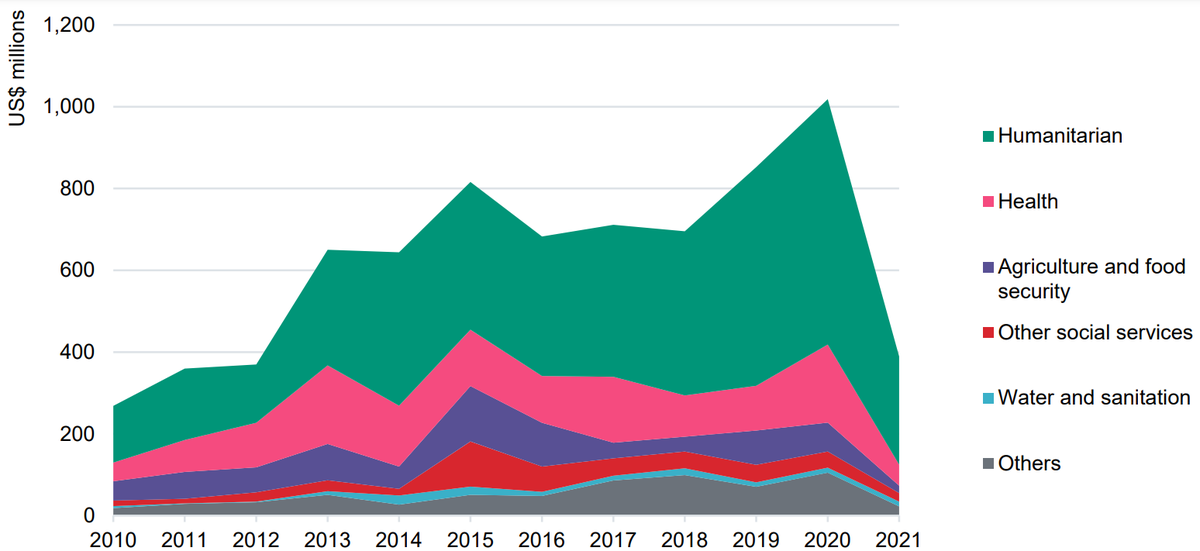
Nutrition-sensitive disbursements by sector, 2010–2021
Notes: Constant 2021 prices. ‘Others’ include ‘Environment’, ‘Education’, ‘Governance and security’, ‘Business and industry’, ‘Infrastructure’, ‘General budget support’ and ‘Other’.
Source: Development Initiatives’ calculations based on DAC CRS data.
Humanitarian and health sectors
A large proportion of the reduction in total nutrition-sensitive funding between 2020 and 2021 was due to changes in nutrition-sensitive spending on both humanitarian and health programmes. The total nutrition-sensitive spending in the humanitarian sector reduced by US$335.4 million to US$264.8 million. This was the first year with a decrease in humanitarian spending since 2012 and brought the total amount of nutrition-sensitive humanitarian spending down to 2013 levels. Nutrition-sensitive spending on the health sector reduced by US$139.5 million to US$51.3 million in 2021.
Nutrition-sensitive humanitarian spending represents 68.0% of FCDO’s total 2021 nutrition-sensitive spending, which is more than 2020 (58.9%). This is the highest proportion since this analysis began in 2010. Nutrition-sensitive health spending represents 13.2% of total nutrition-sensitive spending, compared to 18.7% in 2020. This pattern is consistent with previous years when the majority of such funding has been to humanitarian programmes, with programmes in the health sector accounting for the second greatest proportion.
Other sectors
FCDO's nutrition-sensitive funding for other sectors changed in the following ways:
- Spending for Other social services decreased by US$18.4 million to US$21.1 million in 2021, representing 5.4% of funding (compared to 3.9% in 2020).
- Agriculture and food security reduced by US$52.8 million to US$18.0 million in 2021, representing 4.6% of the total (compared to 7.0% in 2020). This is the lowest since analysis began in 2010.
- Nutrition-sensitive spending for Water and sanitation decreased by US$0.5 million to US$11.7 million, representing 3.0% of total nutrition-sensitive spending in 2021 (compared to 1.2% in 2020).
- Governance and security nutrition-sensitive spending decreased by US$29.4 million to US$6.9 million in 2021, representing 1.8% of total nutrition-sensitive funding (compared to 3.6% in 2020).
- Spending for Education decreased by US$30.5 million to US$2.5 million in 2021, representing 0.6% of funding (compared to 3.2% in 2020).
Despite the decrease in the amount of nutrition-sensitive spending in these sectors between 2020 and 2021, the proportion of nutrition-sensitive spending for each sector was generally consistent with 2020.
The only sector for which nutrition-sensitive spending increased in 2021 was the Environment sector , where spending rose by US$1.0 million to US$8.2 million, representing 2.1% of total nutrition-sensitive spending (compared to 0.7% in 2020). This change was driven by an increase in the number of nutrition-sensitive programmes in the environment sector, from five programmes in 2020 to 17 in 2021. (See Annex 5 for detail about sectors not represented in Figure 5.)
Sector: proportion of nutrition-related spend and programmes within each sector
Figure 7. Over half (51%) of FCDO’s humanitarian programmes were nutrition-sensitive in 2021, the most of any sector
Programmes by key sectors and types, 2021
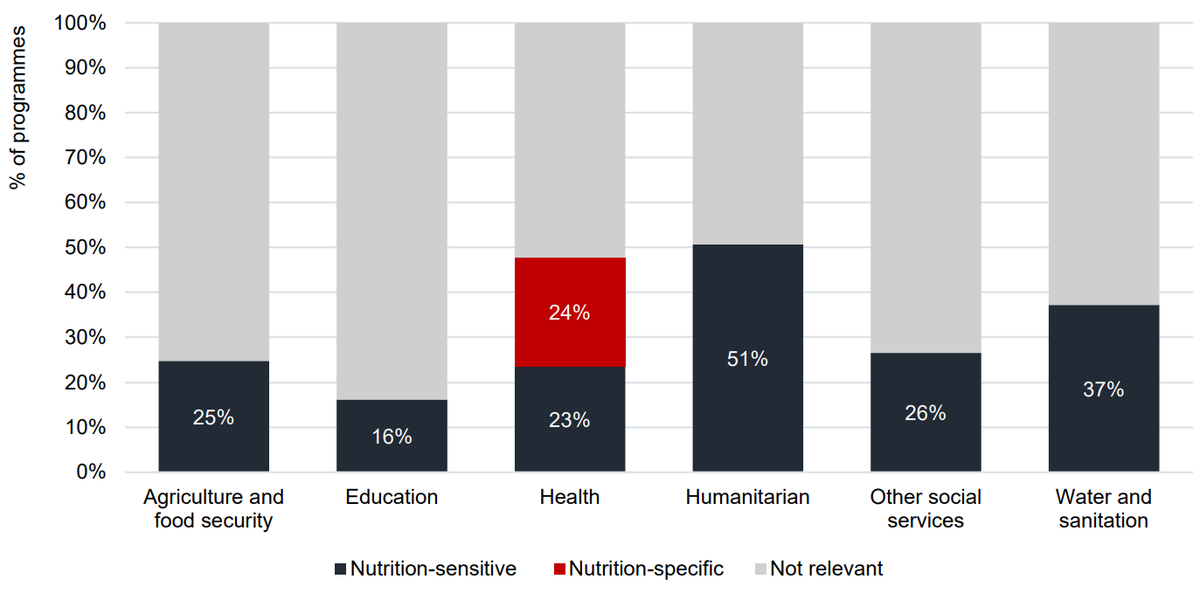
Programmes by key sectors and types, 2021
Notes: Proportion of programmes calculated using total number of FCDO programmes
Source: Development Initiatives’ calculations based on DAC CRS data.
Humanitarian and health sectors
By share of FCDO’s spending in each sector, 27% of humanitarian spending was nutrition-sensitive in 2021 (Figure 6), down slightly from 29% in 2020. By number of programmes, 51% of FCDO’s 2021 humanitarian programmes were nutrition-sensitive to some degree (up from 44% in 2020) (Figure 7).
The share of nutrition-sensitive health spending increased slightly in 2021, from 10% to 11%, and the proportion of nutrition-sensitive health programmes rose from 20% in 2020 to 23% in 2021. An additional 11% of health spending was nutrition specific, up from 7% in 2020 to 11% in 2021. The proportion of health sector programmes that were nutrition specific to some degree increased slightly from 23% in 2020 to 24% in 2024. [6]
Other sectors
For other sectors, the proportion of FCDO’s spending that was nutrition sensitive, and the proportion of programmes that were to some degree nutrition sensitive changed in the following ways:
For Water and sanitation , the share of spending that was nutrition sensitive increased in 2021, from 9% to 14%. The percentage of programmes that were nutrition-sensitive to some degree increased from 17% to 37%.
The proportion of Agriculture and food security spending that was nutrition sensitive reduced from 22% in 2020 to 13% in 2021. The percentage of nutrition-sensitive programmes reduced from 29% to 25%.
The proportion of Education spending that was nutrition sensitive reduced slightly in 2021, from 6% to 4%; however, the percentage of nutrition-sensitive education programmes increased from 1% to 16%.
The share of Other social services spending that was nutrition sensitive remained 12% in 2021. The percentage of nutrition-sensitive programmes increased slightly from 24% in 2020 to 26% in 2021.
By this measure, the Infrastructure sector was the least nutrition sensitive, with just 0.5% of disbursements being nutrition-sensitive in 2021, which is a reduction compared to the 1% seen in 2020.
Purpose codes
DAC CRS purpose codes offer an additional level of detail about the aim of spending across sectors. The bulk of FCDO’s nutrition-sensitive spending has fallen under a select number of purpose codes since 2010, although the distribution of spending across these codes fluctuates (Figure 8).
Figure 8. The proportion of spending on material relief assistance and services increased in 2021, while spending on other purpose codes generally decreased
Proportion of nutrition-sensitive disbursements by DAC CRS purpose code, 2010–2021
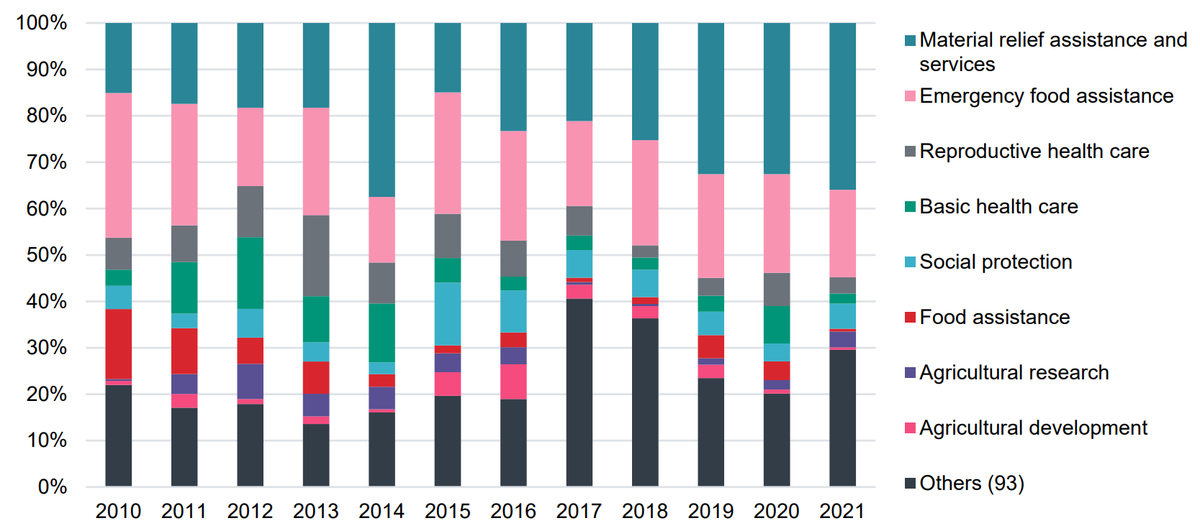
Proportion of nutrition-sensitive disbursements by DAC CRS purpose code, 2010–2021
Source: Development Initiatives’ calculations based on DAC CRS data.
Since 2016, Material relief assistance and services (which includes the provision of shelter, water, sanitation, health services, medicines and other non-food relief items) has accounted for the greatest amount and share of nutrition-sensitive spending. Nutrition-sensitive disbursements for Material relief assistance and services reduced by US$191.9 million (to US$139.9 million in 2021); however, due to reductions, the proportion of funding for this purpose code that was nutrition-sensitive increased from 33% to 36%.
Emergency food assistance again accounted for the second-greatest amount of nutrition-sensitive spending, despite disbursements reducing by US$142.9 million to US$73.4 million in 2021, and the proportion of nutrition-sensitive spend reducing from 21% to 19%.
Nutrition-sensitive spending decreased to Basic health care (down US$73.4 million to US$8.5 million in 2021), Food assistance (down US$38.8 million to US$2.3 million in 2021), Reproductive health care (down US$59.6 million to US$13.7 million in 2021), and Agriculture development (down US$6.8 million to US$2.0 million in 2021).
Despite decreases in spending on Social protection (down US$18.2 million to US$21.1 million in 2021) and Agricultural research (down US$7.5 million to US$13.3 million in 2021), the proportion of spend on these purpose codes increased slightly in 2021 (from 4% to 5%, and from 1% to 3% respectively).
Among 93 Other purpose codes (not specified in Figure 8), nutrition-sensitive spending increased in 35, remained constant in 35 and decreased in 23. By volume, the greatest increases were among Immediate post-emergency reconstruction and rehabilitation (up US$5.4 million to US$9.0 million in 2021), Basic sanitation (up US$2.1 million to US$3.5 million in 2021) and Environment research (up US$2.1 million to US$8.0 million in 2021). The greatest decreases were among Primary education (down US$33.0 million from 2020 with zero funding in 2021), and Public sector policy and administrative management (down US$30.0 million from 2020 with zero funding in 2021). See Annex 5 for more.
Recipients of nutrition ODA disbursements
Regions
The geographic distribution of supported programmes has remained fairly consistent across regions since 2010. In 2021, FCDO’s net nutrition-related spending decreased to all regions (Figure 9).
Figure 9. Net spending decreased to all regions
Nutrition disbursements by region, 2010–2021
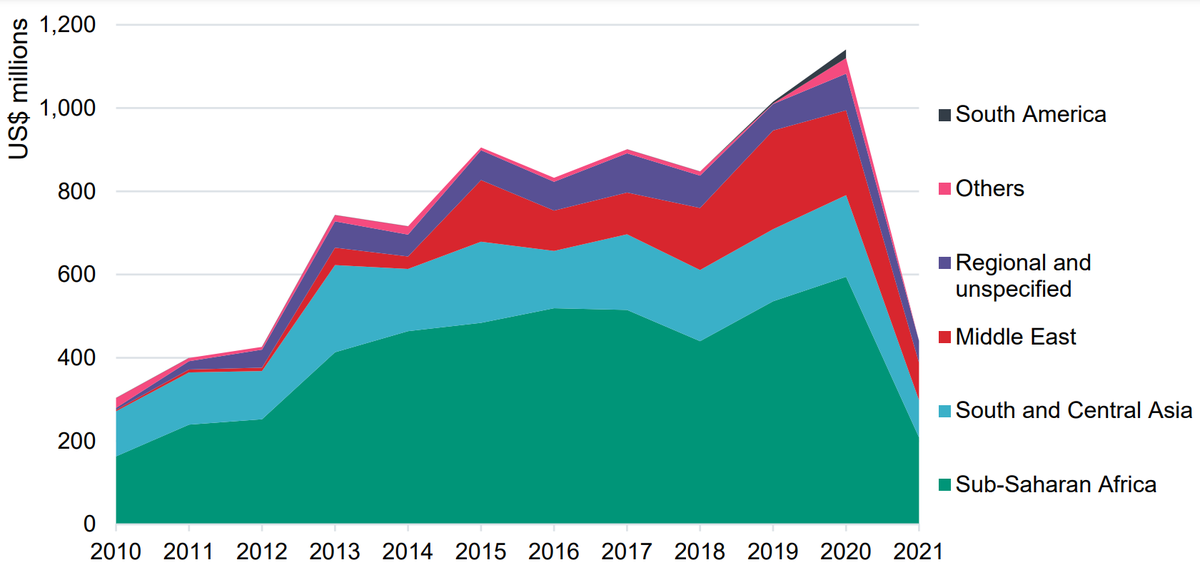
Nutrition disbursements by region, 2010–2021
Notes: Constant 2021 prices. ‘Regional and unspecified’ refers to funding allocated to an unspecified region, or not allocated to a single region. ‘Others’ includes funding allocated to the West Indies, to Africa and to Asia with no further specification.
Source: Development Initiatives’ calculations based on DAC CRS data.
Sub-Saharan Africa remains the greatest recipient by volume, despite a 65% decrease in nutrition-related spending, from US$594.6 million in 2020 to US$208.6 million in 2021. The greatest proportional reduction is seen for South America, which decreased from US$20.6 million to US$0.2 million in 2021, a 99% decrease.
South and Central Asia received 54% less ODA in 2021 (down from US$196.0 million in 2020 to US$89.6 million in 2021). Spending in the Middle East, which spiked in 2019 due to activity in Yemen, fell for the second year in a row, decreasing by 56% between 2020 and 2021, down from US$204.0 million in 2020 to US$90.0 million in 2021.
Countries
The breakdown of funding, 2021
The pattern of funding in 2021 is similar to 2020 in that most countries received either nutrition-sensitive support exclusively or received both nutrition-specific and nutrition-sensitive support. Yemen was the greatest country recipient by volume for the fourth consecutive year.
Figure 10. Yemen again received the largest amount of FCDO nutrition aid
Nutrition disbursements by country/territory
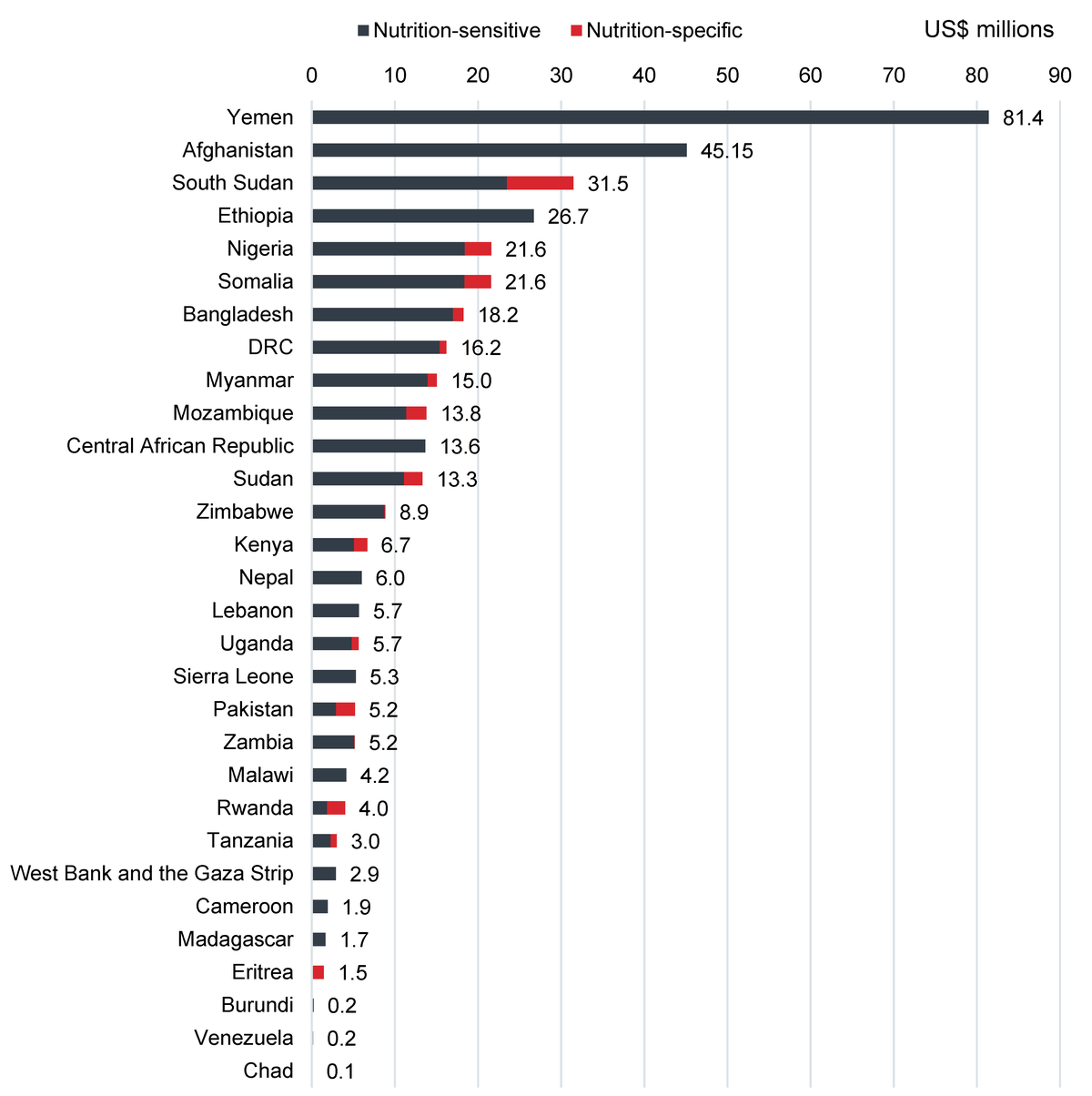
Nutrition disbursements by country/territory
Notes: DRC = Democratic Republic of the Congo. Excludes regional and global level disbursements. Constant 2021 prices. Country and territory labels are consistent with DAC CRS labelling.
Source: Development Initiatives’ calculations based on DAC CRS data
There were 16 countries that received a combination of both nutrition-specific and nutrition-sensitive support, two of which (Eritrea and Rwanda) received more nutrition-specific support than nutrition-sensitive support. Exclusively nutrition-sensitive support went to 14 countries in 2021, including Yemen with US$81.4 million, Afghanistan with US$41.5 million and Ethiopia with US$26.7 million. No country received only nutrition-specific support.
The changes in funding, 2020 to 2021
In 2021, the total number of countries and territories supported by an FCDO nutrition-related programme decreased for the second year in a row, from 32 in 2020 to 30. There were three countries where funding ceased (Syria, Liberia and India), and one newly funded country (Madagascar). As FCDO’s total nutrition-related spending decreased, the mean annual amount received by any country has decreased from US$31.2 million in 2020 to US$12.9 million in 2021.
Figure 11. FCDO increased disbursements to three countries, but decreased disbursements to 30 others
Changes in nutrition disbursement by country, 2020–2021
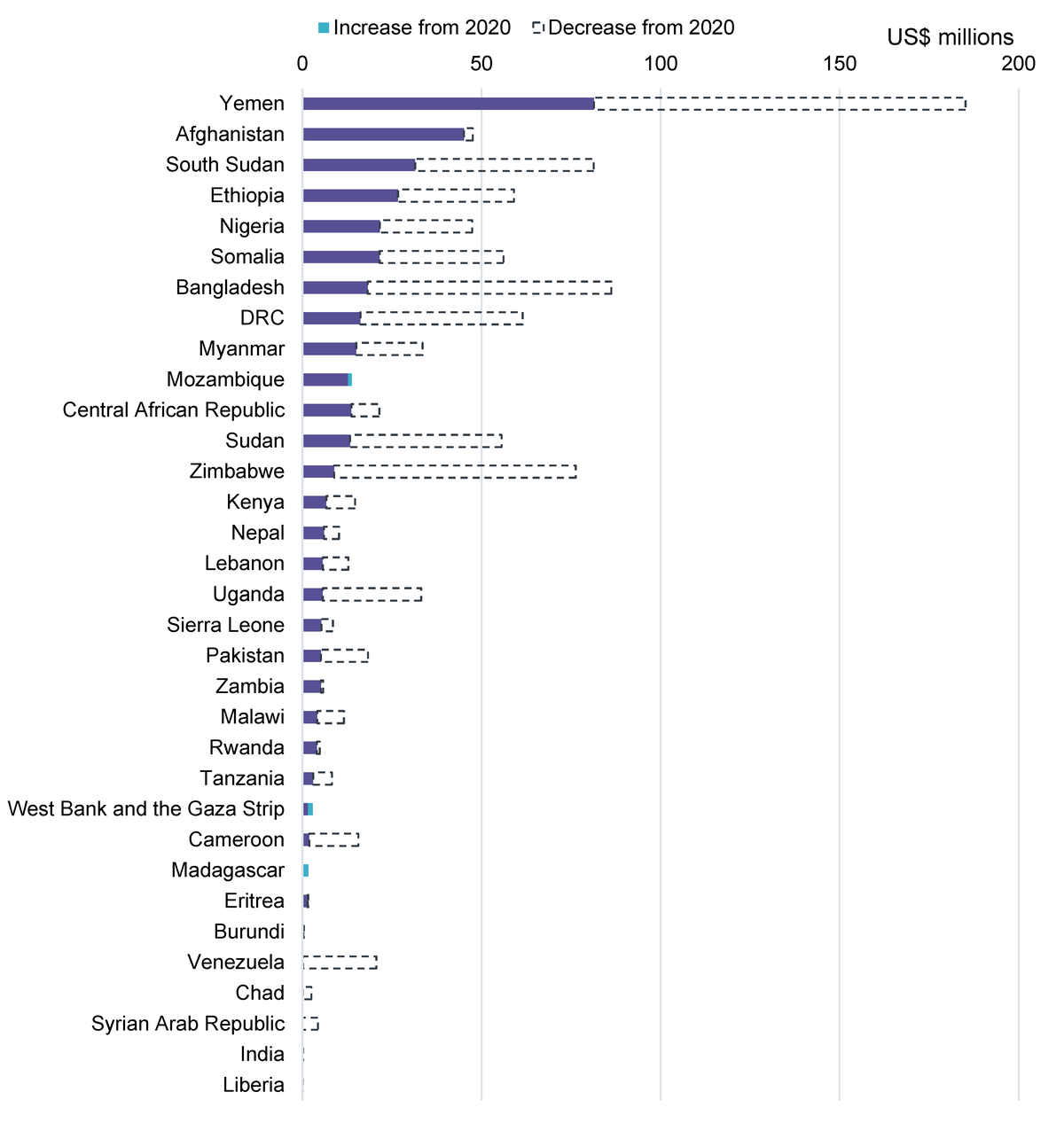
Changes in nutrition disbursement by country, 2020–2021
Notes: DRC = Democratic Republic of the Congo. Excludes regional and global level disbursements. Constant 2021 prices. Country and territory labels are consistent with DAC CRS labelling.
Source: Development Initiatives’ calculations based on DAC CRS data.
FCDO increased total nutrition-related spending in two countries/territories from 2020 to 2021 (Figure 11). These are West Bank and the Gaza Strip (up US$1.3 million to US$2.9 million) and Mozambique (up US$1.0 million to US$12.8 million). Additionally, Madagascar was newly funded in 2021 compared to 2020, receiving US$1.7 million.
Spending decreased to 30 other countries, including three countries where funding for nutrition-related programmes ceased: Syria, Liberia and India. Spending decreased most notably in Yemen (down US$103.7 million to US$81.4 million), Bangladesh (down US$68.0 million to US$18.2 million) and Zimbabwe (down US$67.5 million to US$8.9 million). Despite the decrease in disbursements, the proportion of FCDO’s total nutrition-related disbursements to Yemen was fairly consistent between 2020 (16% of FCDO’s total nutrition spending) and 2021 (18%).
FCDO’s aid spending for nutrition and the gender marker
The OECD DAC’s gender equality marker, defined as “a statistical tool to record aid activities that target gender equality as a policy objective” (OECD, 2016), is used to identify ODA relevant to gender equality and women’s rights.
A marker is used by reporting organisations to signal the policy objectives of a programme – in this case, gender equality. Reporters can mark a programme as having either a significant or principal gender equality policy objective, signalling the relevance of each marked programme. Those marked as ‘principal’ have gender equality as a primary objective, whereas programmes marked as ‘significant’ may have other key objectives, while retaining gender equality as a deliberate objective. The following section refers to the sum of ODA associated with programmes marked as ‘significant’ and ‘principal’. It should be stressed that ODA identified in this way should be considered an estimate only.
In 2021, FCDO screened its programmes using the OECD DAC gender equality policy maker for the third consecutive year. The resulting data shows that the proportion of FCDO’s nutrition spending marked relevant to gender equality remains consistent (79% in 2020 compared to 78% in 2021).
Of FCDO’s nutrition-sensitive spending, 83% was gender relevant (up from 80% in 2020). Of nutrition-specific spending, 42% was gender-relevant (down from 64% in 2020). In 2021, FCDO spent US$0.05 million of nutrition-sensitive ODA on programmes specifically designed for ending violence against women and girls, identifiable using the OECD DAC purpose codes. This is lower than the US$1.6 million spent in 2020.
Figure 12. 78% of FCDO's nutrition spending had gender policy objectives in 2021
Gender-relevant nutrition disbursements, 2015–2021
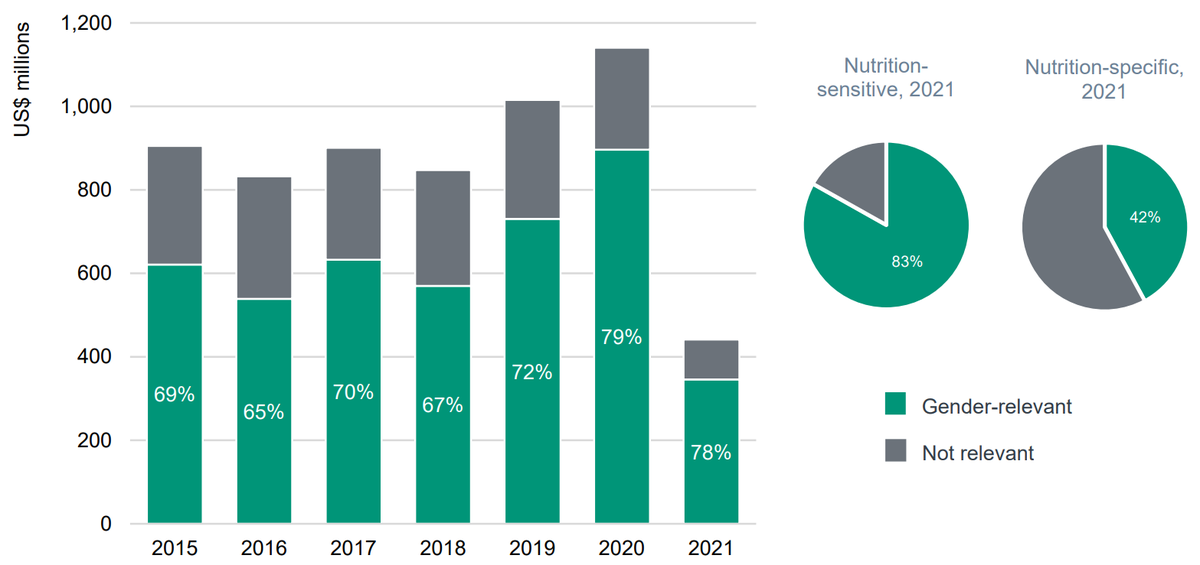
Gender-relevant nutrition disbursements, 2015–2021
Notes: Gender-relevant refers to disbursements reported as having a significant or principal gender equality policy objective. Constant 2021 prices.
Source: Development Initiatives’ calculations based on DAC CRS data.
FCDO’s aid spending for nutrition and climate
International Climate Finance (ICF) is ODA from the UK to support developing countries to reduce poverty and respond to the causes and impacts of climate change. These investments help developing countries to:
- adapt and build resilience to the current and future effects of climate change,
- pursue low-carbon economic growth and development,
- protect, restore and sustainably manage nature, and
- accelerate the clean energy transition (Foreign, Commonwealth and Development Office, 2023).
ICF is not a centrally managed fund but is a designation of ODA that allows the FDCO to deliver climate outcomes.
To estimate the connection between FCDO’s bilateral ICF spend and nutrition-related spending, the list of ICF programmes provided by FCDO was triangulated with historical OECD CRS data to produce the number and details of FCDO programmes that are:
- nutrition-related and reported as ICF,
- nutrition-related but not considered ICF or
- ICF programmes that are not nutrition related.
The historical OECD CRS data in this section was downloaded on 16 May 2023, and analysis includes all projects with disbursements within the assessment window. Therefore, this analysis may exclude active ICF projects with no disbursements in the assessment window. Additionally, the present analysis contains a limited underrepresentation of bilateral ICF spend due to retrospective changes to the OECD CRS dataset and resulting differences between what is reported on the OECD CRS and FCDO’s internal monitoring systems.
ICF spending which includes nutrition objectives
Between 2010–2021, 6% of FCDO’s bilateral ICF spend contained nutrition objectives (nutrition-sensitive and/or nutrition specific as per the SDN methodology used throughout this report). 5% of ICF spending in 2021 was nutrition related, compared to 6% in 2020 (Figure 13).
Figure 13. 5% of FCDO’s International Climate Finance spending was nutrition related in 2021
Proportion of nutrition-related disbursements from overall ICF spending, 2010–2021
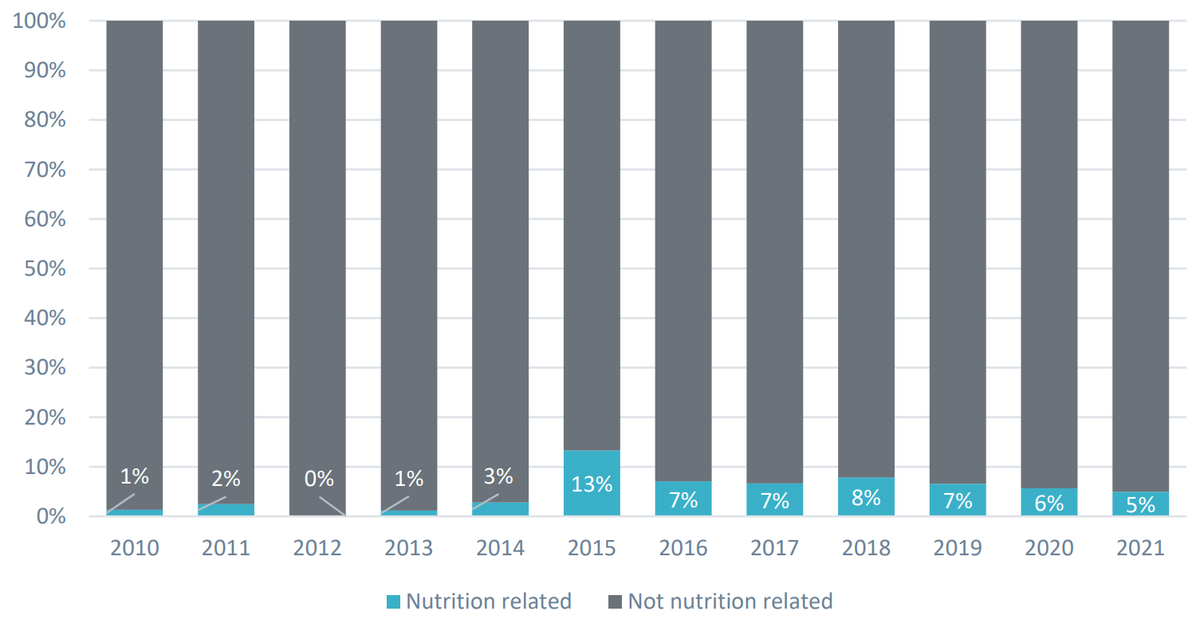
Proportion of nutrition-related disbursements from overall ICF spending, 2010–2021
Source: Development Initiatives’ calculations based on ICF component data provided by FCDO and historical DAC CRS data.
In terms of programmes with ICF spend, 19% (26 programmes) were also nutrition related in 2021, an increase of 2% (representing 5 programmes) from 2020 (Figure 14). Overall, between 2010 and 2021, 17% of programmes with ICF spend (62 programmes) were also nutrition related.
Figure 14. 19% of programmes with International Climate Finance spending were also nutrition relevant in 2021
Proportion of ICF programmes with nutrition-relevant spending, 2010–2021
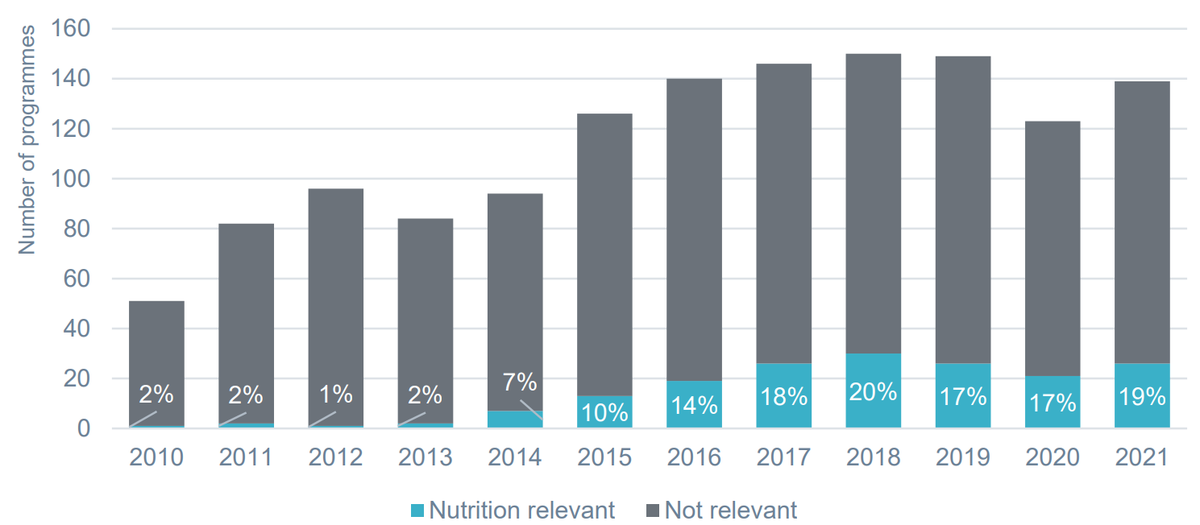
Proportion of ICF programmes with nutrition-relevant spending, 2010–2021
Notes: Constant 2021 prices.
Source: Development Initiatives’ calculations based on ICF component data provided by FCDO and historical DAC CRS data.
Annex 1: Methodology
Identifying nutrition-specific ODA projects
Donors reporting to the CRS, including FCDO, must specify in some detail the sector [7] that their ODA investments intend to support, using a defined list of purpose codes that classify activities – enabling a view of each donor’s support across key sectors.
The SDN methodology defines all projects recorded under the ‘basic nutrition’ CRS purpose code (12240) as ‘nutrition-specific’. In 2017, a revised code was adopted that included some amendments, most notably the removal of school feeding and household food security.
At the time of reporting for 2021 spending, as assessed in this report, this code captures reported spend on (OECD, 2021):
- Micronutrient deficiency identification and supplementation
- Infant and young child feeding promotion, including exclusive breastfeeding
- Non-emergency management of acute malnutrition and other targeted feeding programmes (including complementary feeding)
- Staple food fortification, including salt iodisation
- Nutritional status monitoring and national nutrition surveillance
- Research, capacity building, policy development, monitoring and evaluation in support of these interventions.
Generally, donors report their projects to the CRS either under a single purpose code, based on the project’s main objective or sector, or under a ‘multi-sector’ purpose code. FCDO’s reporting to the CRS is more detailed, as is that of some other donors, such as Canada. FCDO divides its projects into different components and assigns each a relevant CRS purpose code. Each component appears in the CRS as a separate record. In some cases, an FCDO CRS record represents the whole project. In others, a record represents only part of a broader project, with the other components appearing as separate purpose codes.
Because of this, for the original 2010–2012 assessment, the application of the SDN methodology to FCDO’s CRS records under the ‘basic nutrition’ purpose code was adapted, with the agreement of the SDN. In this analysis, all FCDO project components coded to ‘basic nutrition’ in the CRS are counted in full as nutrition specific. Spending recorded against these components is used to determine FCDO’s total ODA funding to nutrition-specific interventions.
Other components of these projects recorded under any other CRS purpose code have been classified as ‘nutrition-sensitive’ (see Annex 2 for a record of projects with both specific and sensitive components).
Identifying nutrition-sensitive ODA projects
The SDN methodology uses a three-step approach to identify nutrition-sensitive projects. In the methodology used, an additional step is needed to account for FCDO’s detailed CRS reporting. The steps used in this analysis are outlined below.
Step 1: Identify potentially nutrition-sensitive projects
Projects that are likely to be nutrition-sensitive are first identified in the CRS database using a purpose code filter and a keyword search. The purpose code filter selects all projects coded under relevant nutrition-sensitive purpose codes (Table 2). A keyword search is applied to the description field of all other CRS records under the remaining purpose codes (Box 1). The purpose code filter and keyword search yield a pool of potentially nutrition-sensitive records. As explained above, for FCDO, these records represent project components rather than whole projects.
Table 2. DAC CRS purpose codes used to identify nutrition-sensitive projects
Availability
31110 Agricultural policy and administrative management
31120 Agricultural development
31140 Agriculture water resources
31150 Agricultural inputs
31161 Food crop production
31163 Livestock
31166 Agricultural extension
31181 Agricultural education/training
31182 Agricultural research
31191 Agricultural services
31193 Agricultural financial services
31194 Agricultural cooperatives
31310 Fishing policy and administrative management
31320 Fishery development
31381 Fishery education and training
43040 Rural development
Accessibility
16010 Social welfare services
16011 Social protection
52010 Food aid/food security programs
72010 Material relief assistance and services
72040 Humanitarian/emergency relief
72050 Relief coordination, protection and support services
73010 Reconstruction, relief and rehabilitation
Public health (including reproductive health)
12110 Health policy and administrative management
12220 Basic health care
12250 Infectious disease control
12261 Health education
12281 Health personnel development
13020 Reproductive health care
13022 Maternal health (including neonatal health)
Sanitation
14030 Basic drinking water supply and sanitation
14032 Basic sanitation
Drinking water
14031 Basic drinking water supply
Gender empowerment
15170 Women’s equality organizations and institutions
Other
51010 General budget support
Box 1
Keywords used to identify nutrition-sensitive projects
Aflatoxin; biofortification; breastfeeding; cash transfer; child feeding; CMAM; community management of acute malnutrition; deworming; diarrheal disease; diet; dietary diversification; direct feeding; enteropathy; feeding; feeding program; feeding programme; food intake; food intake; food security; food subsidy; food voucher; fortification; GAM; global acute malnutrition; garden; gastrointestinal illness; global nutrition coordination; growth monitoring; growth monitoring and promotion; handwashing; helminth; hunger; hygiene; IUGR; intrauterine growth restriction; iodine; iron; iron–folic acid; iron folic acid; low birthweight; maternal feeding; MAM; mineral; moderate acute malnutrition; malnutrition; micronutrient; nutrition; nutrition education; ready to use therapeutic food; ready-to-use therapeutic food; ready-to-use-therapeutic-food; RUTF; SAM; severe acute malnutrition; Scaling Up Nutrition; school feeding; stunting; supplement; supplementation; under nutrition; undernutrition; under-nutrition; under weight; underweight; under-weight; vitamin; wasting; zinc.
Step 2: Review project documents to assess whether projects meet nutrition-sensitive criteria
The project documents for all components identified in Step 1 are reviewed to determine whether they are nutrition sensitive. This assessment primarily uses publicly available documents published through FCDO’s Development Tracker . Projects with insufficient publicly available information are raised with FCDO officials, who provide relevant documentation to enable an assessment.
To qualify as nutrition-sensitive, a project must meet three of the following criteria. The project must:
- be aimed at individuals (specifically women, adolescent girls or children)
- include nutrition as a significant objective or indicator
- contribute to at least one nutrition-sensitive outcome as per the SDN methodology (Table 3).
Table 3. Examples of nutrition-sensitive outcomes from the SDN methodology
Nutrition-sensitive outcomes
- Increase purchasing power of women (examples: safety nets, cash transfers).
- Improve access to nutritious food for women, adolescent girls and/or children (examples: agriculture/livestock diversification, biofortification, food safety, increased access to markets).
- Improve diet in quality and/or quantity for women, adolescent girls or children (examples: promotion of quality/diversity, nutritious diets, quantity/energy intake in food-insecure households, stability, micronutrient intake, vouchers, access to markets).
- Improve access of women or adolescent girls or children to primary health care (examples: maternal health care, child health care, reproductive health care, supplementation, therapeutic feeding, support with breastfeeding).
- Improve access to childcare (i.e. childcare not supplied through the health services).
- Improve women’s or adolescent girls’ or children’s access to water, sanitation and hygiene (examples: access to latrines, access to safe water, improvement of hygiene).
- Improve access to education/school for adolescent girls.
- Improve knowledge/awareness on nutrition for relevant audiences (examples: inclusion of nutritional education in primary and secondary education curricula, TV and radio spots addressing vulnerable households and decision-makers, nutrition awareness campaigns).
- Improve empowerment of women (examples: access to credit, women-based smallholder agriculture, support to women’s groups).
- Improve governance of nutrition (examples: increased coordination of actors and policies for nutrition, establishment of budgets specifically contributing to nutrition, improvement of institutional arrangements for nutrition, improved nutrition information systems, integration of nutrition in policies and systems).
- Increase nutrition-sensitive legislation (examples: food-fortification legislation, right-to-food, legislation for implementing the Code of Marketing of Breastmilk Substitutes, food safety).
- Increased research with nutrition objectives.
While identifying explicit nutrition targets and objectives among project documents is straightforward, applying the first criterion (aimed at individuals) is more subjective. The SDN methodology requires a project to intend to improve nutrition for women or adolescent girls or children to be considered nutrition-sensitive. The methodology adds that, “this does not necessarily entail targeting women or children, because actions targeted at households, communities or nations can also be designed to result in improved nutrition for women and children. It entails, though, an intention to achieve results and measure them at the level of women, adolescent girls or children” (SDN, 2013).
This analysis considered a project to be aimed at individuals when there was evidence of explicit or implicit intent among project documents to achieve results and measure them at an individual level. In the case of FCDO, some nutrition-sensitive projects track progress at the household level. Projects that only tracked progress at the household level and not at the individual level (e.g. numbers of children or numbers of women) were only considered to be aimed at individuals when there was at least a clearly stated objective to improve nutrition of individuals.
A project’s objectives and indicators are considered nutrition-sensitive if they demonstrate an intention to improve nutrition (e.g. ‘improving malnutrition’ and ‘reducing incidence of malnutrition’) or refer to actions that do this (e.g. through improvement in dietary diversity, breastfeeding and vitamin supplementation). Project objectives or indicators that focus only on actions that could lead to improved nutrition outcomes, but do not refer to nutrition explicitly, are not considered nutrition-sensitive (e.g. cash transfers, access to education or sanitation services not explicitly aimed at improving nutrition).
Finally, nutrition-sensitive projects must contribute toward nutrition-sensitive outcomes as defined in the SDN methodology. Only when all three of these criteria are met can a project qualify as nutrition sensitive.
Annex 3 provides examples of how these criteria are applied to specific projects.
Step 3: Determine the total project spend for nutrition-sensitive projects in the case of FCDO’s CRS records
As FCDO reports at the component level, it is possible that a project identified as nutrition-sensitive under the criteria described in Step 2 will have components elsewhere in the CRS database that are not captured in Step 1. In some cases, not all components are reported using one of the codes or captured using the keywords. To account for this, the additional components of nutrition-sensitive projects are identified manually by searching for components with the same project identification number in the CRS, in line with what was agreed by SDN members for the original 2010–2012 FCDO nutrition-spending assessment. For each project, total spend is calculated as the sum of all the project’s components.
Step 4: Classify nutrition-sensitive projects as ‘dominant’ or ‘partial’
The final step of the SUN methodology classifies nutrition-sensitive projects as one of two sub-categories: ‘dominant’ or ‘partial’, depending on the extent to which projects contribute to nutrition-sensitive outcomes.
The SUN methodology requires that:
- when the full project (its main objective, results, outcomes and indicators) is nutrition-sensitive, the project is classified as ‘nutrition-sensitive dominant’ and the total spend for the project is counted
- when part of the project (e.g. one of the objectives, results, outcomes or indicators) is nutrition-sensitive, but also aims to address other issues, the project is classified as ‘nutrition-sensitive partial’ and 25% of the project spend is counted.
Annex 3 provides examples of how projects are assessed as dominant or partial.
Annex 4 provides an illustration of these steps.
ODA disbursements and commitments
The CRS database has two measures of ODA: ‘disbursements’ and ‘commitments’. Commitments are a formal obligation to disburse funds; disbursements are the funds that donors have actually provided. Commitments and disbursements from a donor will differ by year. This is because commitments often relate to projects that disburse funds over a number of years. Also, disbursements may be made where no previous commitments existed, and the final disbursed cost of a project may differ from the originally committed amount.
As disbursements measure the resources transferred to countries in a given reporting year, this analysis reports primarily on FCDO’s disbursements. These figures may not match the UK’s Statistics on International Development (SID) data as SID data presents net ODA figures.
Constant versus current prices
In this report, FCDO’s spending on nutrition is assessed and expressed in constant US$ 2021 prices. This negates to a degree the effects of annual exchange rate changes and domestic price inflation on the way spending trends appear. This can also allow for more meaningful comparisons over time.
Consistent with the approach used in previous assessments, constant US$ prices are calculated from financial data as reported to the OECD DAC CRS and the OECD DAC’s deflators.
Spending figures presented in previous reports were also presented in a constant series, aligned with the latest year for which there was available data. This report on FCDO’s spending up to 2021 presents data in a constant 2021 series.
Annex 2: Programmes with nutrition-specific and nutrition-sensitive components
Table 4. Details of programme with both nutrition-specific and nutrition-sensitive components active in 2021
| Number | Project Title | Programme Classification |
|---|---|---|
| 201874 |
Working to Improving Nutrition in Northern Nigeria
(WINNN) [GB-1-201874] |
Nutrition-specific and nutrition-sensitive dominant |
| 203551 |
Tackling Maternal and Child Undernutrition Programme-
Phase II [GB-1-203551] |
Nutrition-specific and nutrition-sensitive dominant |
| 203631 |
Addressing Stunting in Tanzania Early Programme
[GB-1-203631] |
Nutrition-specific and nutrition-sensitive dominant |
| 203852 | Yemen Humanitarian Resilience Programme [GB-1-203847] | Nutrition-specific and nutrition-sensitive partial |
| 203981 |
Linking Agribusiness and Nutrition in Mozambique
[GB-1-203981] |
Nutrition-specific and nutrition-sensitive dominant |
| 204019 |
South Sudan Humanitarian Programme (HARISS) 2014 -
2020 [GB-1-204019] |
Nutrition-specific and nutrition-sensitive partial |
| 204023 |
Supporting Nutrition in Pakistan
(SNIP) [GB-1-204023] |
Nutrition-specific and nutrition-sensitive dominant |
| 204131 |
Ending the Cycle of Undernutrition in Bangladesh -
Suchana [nutsen] [GB-1-204131] |
Nutrition-specific and nutrition-sensitive partial |
| 204189 | Burma UK Health Partnership Programme [GB-1-204189] | Nutrition-specific and nutrition-sensitive partial |
| 204196 |
Burma Humanitarian Assistance and Resilience
Programme [GB-1-204196] |
Nutrition-specific and nutrition-sensitive partial |
| 204457 | Complementary food production (CHAI) [GB-1-204457] | Nutrition-specific and nutrition-sensitive partial |
| 204477 | Exiting Poverty in Rwanda [GB-1-204477] | Nutrition-specific and nutrition-sensitive partial |
| 204903 |
Somali Health and Nutrition Programme (SHINE)
2016-2021 [GB-1-204903] |
Nutrition-specific and nutrition-sensitive partial |
| 205206 |
Building Resilience and an Effective Emergency
Refugee Response (BRAER) [GB-1-205206] |
Nutrition-specific and nutrition-sensitive partial |
| 300028 |
CHURP Central African Republic Humanitarian Recovery
Programme 2016 to 2019 [GB-1-205286] |
Nutrition-specific and nutrition-sensitive partial |
| 300139 |
Kenya Integrated Refugee and Host Community Support
Programme (PAMOJA) [GB-GOV-1-300139] |
Nutrition-specific and nutrition-sensitive partial |
| 300158 |
Kenya Integrated Refugee and Host Community Support
Programme (PAMOJA) [GB-GOV-1-300139] |
Nutrition-specific and nutrition-sensitive partial |
| 300163 |
Supporting a Resilient Health System in Zimbabwe
(SRHS) [GB-GOV-1-300163] |
Nutrition-specific and nutrition-sensitive partial |
| 300196 |
Responding to Protracted Crisis in Sudan:
Humanitarian Reform, Assistance & Resilience Programme [GB-GOV-1-300196] |
Nutrition-specific and nutrition-sensitive partial |
| 300414 |
Support to the United Nations Children's Fund in
Syria [GB-GOV-1-300388] |
Nutrition-specific and nutrition-sensitive partial |
| 300495 | LAFIYA - UK Support for Health in Nigeria | Nutrition-specific and nutrition-sensitive partial |
| 300531 | Africa Humanitarian Response Fund [GB-GOV-1-300531] | Nutrition-specific and nutrition-sensitive partial |
| 300725 |
T-WASH II - Transforming Access to WASH and Nutrition
Services in Mozambique |
Nutrition-specific and nutrition-sensitive dominant |
| 300888 | Global Financing Facility - Phase 2 | Nutrition-specific and nutrition-sensitive partial |
Notes: Nutrition-specific and nutrition-sensitive dominant components were counted in full (100%). In line with the SUN methodology, 25% of nutrition-sensitive partial components were counted.
Annex 3: Determining the level of nutrition sensitivity of projects: worked examples
Example of a nutrition-sensitive project
Support to UNICEF Cholera, Nutrition, Malaria and Primary Health Care Projects for South Sudan Humanitarian Assistance and Resilience Building programme. Project code GB-GOV-1-204019.
This project meets all three of the criteria:
- Aimed at individuals: Number of children (six-59 months), women, adolescents treated with severe or moderate acute malnutrition
- Significant nutrition objective or indicator: Number of children (six-59 months), women, adolescents treated with severe or moderate acute malnutrition
- Contribution to nutrition-sensitive outcomes: Improve women’s or adolescent girls’ or children’s access to water, sanitation and hygiene: Improved access to water, hygiene and sanitation facilities.
This project is therefore classified as nutrition sensitive .
Example of a discounted project
Agribusiness Africa Round 3 Women's Economic Empowerment in Agriculture. Project code GB-GOV-1-200094.
This project does not meet all three criteria:
- Aimed at individuals: The project does not have any (direct) actions relating to improving nutrition
- Significant nutrition objective or indicator: This project has no evidence of a nutrition objective or indicator
- Contribution to nutrition-sensitive outcomes: The project has no evidence of nutrition-sensitive outcomes.
This project is therefore classified as not nutrition sensitive .
Example of a nutrition-sensitive dominant project
Linking Agribusiness and Nutrition – Development of a SUN Business Network (GAIN). Project code GB-GOV-1- 203981.
All its actions contribute to nutrition-sensitive outcomes, including improved access to primary healthcare.
This project is therefore classified as nutrition-sensitive dominant .
Example of a nutrition-sensitive partial project
Livelihoods and Food Security Trust Fund for the rural poor and vulnerable in Burma. Project code GB-GOV-1- 201239.
This project meets all three of the criteria.
Not all of its actions contribute to nutrition-sensitive outcomes.
This project is therefore classified as nutrition-sensitive partial .
Annex 4: Programme classification
Annex 5: Nutrition-sensitive ODA by DAC CRS sector and purpose code
Table 5. Nutrition-sensitive ODA by sector and purpose code, 2021, US$ millions
| DAC CRS sector and purpose code | Disbursements (US$ millions) | |
|---|---|---|
| Emergency response | 241.3 | |
| • Emergency food assistance | 73.4 | |
|
• Material relief assistance and
services |
139.9 | |
|
• Relief co-ordination and support
services |
28.0 | |
| Basic Health | 14.8 | |
| • Basic health care | 8.5 | |
| • Covid-19 control | 2.5 | |
| •Health education | 0.4 | |
| • Health personnel development | 1.8 | |
| •Infectious disease control | 0.4 | |
| • Malaria control | 1.0 | |
| • Tuberculosis control | 0.2 | |
|
Population policies/programmes
and reproductive health |
17.8 | |
| • Family planning | 2.7 | |
|
• Personnel development for
population and reproductive health |
0.5 | |
|
• Population policy and administrative
management |
0.5 | |
| •Reproductive healthcare | 13.7 | |
| • STD control including HIV/Aids | 0.3 | |
|
Development Food Aid/Food
Security Assistance |
2.3 | |
| •Food assistance | 2.3 | |
|
Other social infrastructure and
services |
21.1 | |
| • Social protection | 21.1 | |
| Others | 92.1 | |
| Total | 389.4 |
Notes: US$ millions, 2021 prices.
Source: Development Initiatives’ calculations based on DAC CRS data.
Table 6. Nutrition-sensitive ODA disbursements distribution among DAC CRS codes
| Sectors | ODA disbursements (US$ million): Bilateral ODA | ODA disbursements (US$ million): Nutrition-sensitive ODA |
Nutrition-sensitive ODA as a proportion (%): Total
purpose code ODA |
Nutrition-sensitive ODA as a proportion (%): Total
nutrition- sensitive ODA |
Nutrition-sensitive ODA as a proportion (%): Total
bilateral ODA |
|---|---|---|---|---|---|
|
Material relief assistance and
services |
561.7 | 139.9 | 24.9% | 35.9% | 2.2% |
| Emergency food assistance | 185.4 | 73.4 | 39.6% | 18.9% | 1.2% |
| Basic nutrition | 52.2 | 52.2 | 100.0% | 13.4% | 0.8% |
|
Relief co-ordination and support
services |
138.6 | 28.0 | 20.2% | 7.2% | 0.4% |
| Social Protection | 153.2 | 21.1 | 13.8% | 5.4% | 0.3% |
|
Health policy and administrative
management |
85.3 | 18.3 | 21.4% | 4.7% | 0.3% |
|
Multi-hazard response
preparedness |
90.4 | 14.5 | 16.1% | 3.7% | 0.2% |
| Reproductive health care | 75.7 | 13.7 | 18.1% | 3.5% | 0.2% |
| Agricultural research | 33.9 | 13.3 | 39.3% | 3.4% | 0.2% |
|
Immediate post-emergency reconstruction
and rehabilitation |
43.0 | 9.0 | 20.8% | 2.3% | 0.1% |
| Basic health care | 72.2 | 8.5 | 11.7% | 2.2% | 0.1% |
|
Environmental policy and
administrative management |
119.0 | 8.0 | 6.7% | 2.0% | 0.1% |
|
Facilitation of orderly, safe,
regular and responsible migration and mobility |
46.6 | 3.5 | 7.5% | 0.9% | 0.1% |
| Basic sanitation | 13.8 | 3.5 | 25.5% | 0.9% | 0.1% |
|
Basic drinking water supply and
basic sanitation |
12.0 | 3.4 | 28.6% | 0.9% | 0.1% |
| Family planning | 177.4 | 2.7 | 1.5% | 0.7% | 0.04% |
| Covid-19 control | 203.5 | 2.5 | 1.2% | 0.6% | 0.04% |
| Food assistance | 26.2 | 2.3 | 8.9% | 0.6% | 0.04% |
|
Democratic participation and
civil society |
92.5 | 2.1 | 2.3% | 0.6% | 0.03% |
| Agricultural development | 32.6 | 2.0 | 6.3% | 0.5% | 0.03% |
| Research/scientific institutions | 107.2 | 1.8 | 1.7% | 0.5% | 0.03% |
| Health personnel development | 8.3 | 1.8 | 21.2% | 0.5% | 0.03% |
|
Water sector policy and
administrative management |
10.5 | 1.5 | 14.8% | 0.4% | 0.02% |
|
Small- and medium-sized
enterprises (SME) development |
258.2 | 1.2 | 0.5% | 0.3% | 0.02% |
| Basic drinking water supply | 19.7 | 1.1 | 5.8% | 0.3% | 0.02% |
| Education facilities and training | 77.4 | 1.1 | 1.4% | 0.3% | 0.02% |
| Malaria control | 11.2 | 1.0 | 9.2% | 0.3% | 0.02% |
|
Education policy and administrative
management |
124.8 | 1.0 | 0.8% | 0.3% | 0.02% |
|
Water supply and sanitation –
large systems |
24.8 | 0.9 | 3.7% | 0.2% | 0.01% |
| Road transport | 32.5 | 0.7 | 2.1% | 0.2% | 0.01% |
|
Population policy and
administrative management |
6.9 | 0.5 | 7.9% | 0.1% | 0.01% |
|
Education and training in water
supply and sanitation |
2.4 | 0.5 | 23.0% | 0.1% | 0.01% |
|
Personnel development for
population and reproductive health |
4.2 | 0.5 | 12.8% | 0.1% | 0.01% |
| Medical research | 127.1 | 0.4 | 0.3% | 0.1% | 0.01% |
|
Decentralisation and support to
subnational government |
8.5 | 0.4 | 5.0% | 0.1% | 0.01% |
| Sectors not specified | 31.7 | 0.4 | 1.3% | 0.1% | 0.01% |
| Health education | 4.2 | 0.4 | 9.4% | 0.1% | 0.01% |
| Urban development and management | 38.4 | 0.4 | 1.0% | 0.1% | 0.01% |
| Infectious disease control | 60.4 | 0.4 | 0.6% | 0.1% | 0.01% |
|
Security system management and
reform |
13.6 | 0.3 | 2.4% | 0.1% | 0.01% |
| STD control including HIV/Aids | 6.3 | 0.3 | 4.7% | 0.1% | 0.005% |
| Livestock | 1.7 | 0.3 | 14.7% | 0.1% | 0.004% |
| Human rights | 31.1 | 0.2 | 0.7% | 0.1% | 0.004% |
| Tuberculosis control | 2.9 | 0.2 | 8.0% | 0.1% | 0.004% |
|
Informal/semi-formal financial
intermediaries |
12.2 | 0.2 | 1.8% | 0.1% | 0.003% |
| Environmental research | 12.8 | 0.2 | 1.6% | 0.1% | 0.003% |
| Educational research | 28.5 | 0.2 | 0.7% | 0.1% | 0.003% |
| Sanitation – large systems | 8.5 | 0.2 | 2.3% | 0.1% | 0.003% |
| Business policy and administration | 45.5 | 0.2 | 0.4% | 0.05% | 0.003% |
|
Water resources conservation
(including data collection) |
1.9 | 0.2 | 9.4% | 0.05% | 0.003% |
| Water supply - large systems | 5.4 | 0.2 | 3.0% | 0.04% | 0.003% |
| Public finance management (PFM) | 21.6 | 0.1 | 0.5% | 0.03% | 0.002% |
| Waste management/disposal | 2.3 | 0.1 | 4.6% | 0.03% | 0.002% |
| Vocational training | 10.4 | 0.1 | 1.0% | 0.03% | 0.002% |
|
Civilian peace-building, conflict
prevention and resolution |
33.4 | 0.1 | 0.2% | 0.02% | 0.001% |
|
Ending violence against women and
girls |
20.2 | 0.1 | 0.3% | 0.02% | 0.001% |
|
Women's rights organisations and
movements, and government institutions |
14.4 | 0.04 | 0.3% | 0.01% | 0.001% |
|
Upper Secondary Education
(modified and includes data from 11322) |
60.0 | 0.04 | 0.1% | 0.01% | 0.001% |
|
Agricultural policy and
administrative management |
6.9 | 0.01 | 0.1% | 0.002% | 0.0001% |
|
Anti-corruption organisations and
institutions |
25.5 | 0.01 | 0.03% | 0.002% | 0.0001% |
| Agricultural services | 8.2 | 0.01 | 0.1% | 0.002% | 0.0001% |
| Grand Total | 6278.7 | 389.4 |
Notes: Ordered by nutrition-sensitive ODA disbursements. US$ millions, 2021 prices. The total and relative shares refer to bilateral ODA to all sectors, including those not displayed in the table.
Source: Development Initiatives’ calculations based on DAC CRS data.
Annex 6: Nutrition ODA by recipient
Table 7. FCDO nutrition-related ODA by country and category, 2021, US$ millions
| Country | Nutrition-sensitive | Nutrition-specific | Total |
|---|---|---|---|
| Yemen | 81.4 | 81.4 | |
| Afghanistan | 45.1 | 45.1 | |
| South Sudan | 23.5 | 8.0 | 31.5 |
| Ethiopia | 26.7 | 26.7 | |
| Nigeria | 18.4 | 3.2 | 21.6 |
| Somalia | 18.4 | 3.2 | 21.6 |
| Bangladesh | 17.0 | 1.3 | 18.2 |
| Democratic Republic of the Congo | 15.4 | 0.8 | 16.2 |
| Myanmar | 14.0 | 1.1 | 15.0 |
| Mozambique | 11.4 | 2.4 | 13.8 |
| Central African Republic | 13.6 | 13.6 | |
| Sudan | 11.1 | 2.2 | 13.3 |
| Zimbabwe | 8.7 | 0.1 | 8.9 |
| Kenya | 5.1 | 1.6 | 6.7 |
| Nepal | 6.0 | 6.0 | |
| Lebanon | 5.7 | 5.7 | |
| Uganda | 4.8 | 0.8 | 5.7 |
| Sierra Leone | 5.3 | 5.3 | |
| Pakistan | 2.9 | 2.3 | 5.2 |
| Zambia | 5.1 | 0.0 | 5.2 |
| Malawi | 4.2 | 4.2 | |
| Rwanda | 1.9 | 2.1 | 4.0 |
| Tanzania | 2.3 | 0.7 | 3.0 |
| West Bank and Gaza Strip | 2.9 | 2.9 | |
| Cameroon | 1.9 | 1.9 | |
| Madagascar | 1.7 | 1.7 | |
| Eritrea | 0.1 | 1.3 | 1.5 |
| Burundi | 0.2 | 0.2 | |
| Venezuela | 0.2 | 0.2 | |
| Chad | 0.1 | 0.1 |
Notes: US$ millions, 2021 prices.
Source: Development Initiatives’ calculations based on DAC CRS data.
References
Development Initiatives, 2014. DFID’s aid spending for nutrition: 2010–2012. Available at: http://devinit.org/post/DFIDs-aid-spending-nutrition-2010-2012
Development Initiatives, 2015. DFID’s aid spending for nutrition: 2013. Available at: http://devinit.org/post/DFIDs-aid-spending-for-nutrition-2013
Development Initiatives, 2016. DFID’s aid spending for nutrition: 2014. Available at: http://devinit.org/post/DFIDs-aid-spending-for-nutrition-2014
Development Initiatives, 2017. DFID’s aid spending for nutrition: 2015. Available at: http://devinit.org/post/DFIDs-aid-spending-nutrition-2015
Development Initiatives, 2018. DFID’s aid spending for nutrition: 2016. Available at: http://devinit.org/post/DFIDs-aid-spending-nutrition-2016
Development Initiatives, 2019. DFID’s aid spending for nutrition: 2017. Available at: http://devinit.org/post/DFIDs-aid-spending-nutrition-2017
Development Initiatives, 2019. DFID’s aid spending for nutrition: 2018. Available at: /resources/DFIDs-aid-spending-for-nutrition-2018
Development Initiatives, 2020. DFID’s aid spending for nutrition: 2018. Available at: /resources/DFIDs-aid-spending-for-nutrition-2018
Development Initiatives, 2021. FCDO’s aid spending for nutrition: 2019. Available at: /media/documents/FCDOs_Aid_Spending_for_Nutrition_2019.pdf
Development Initiatives, 2022. FCDO’s aid spending for nutrition: 2020. Available at: /resources/fcdos-aid-spending-nutrition-2020/
Foreign, Commonwealth and Development Office, 2022. Statistics on International Development: Final UK Aid Spend 2021. Available at: https://assets.publishing.service.gov.uk/government/uploads/system/uploads/attachment_data/file/1133445/Statistics-on-International-Development-Final-UK-Aid-Spend-2021.pdf
Foreign, Commonwealth and Development Office, 2023. UK international climate finance results 2022. Available at: https://www.gov.uk/government/publications/uk-climate-finance-results-2022/uk-international-climate-finance-results-2022
Global Nutrition Report, 2021. 2021 Global Nutrition Report: The state of global nutrition. Bristol, UK: Development Initiatives. Available at: https://globalnutritionreport.org/reports/2021-global-nutrition-report/
National Audit Office, 2022. Managing reductions in Official Development Assistance Spending: Foreign, Commonwealth & Development Office. Available at: https://www.nao.org.uk/wp-content/uploads/2022/03/Managing-reductions-in-Official-Development-Assistance-spending-Summary.pdf
OECD, 2016. Handbook on the OECD-DAC Gender Equality Policy Marker. Available at: https://www.oecd.org/dac/gender-development/Handbook-OECD-DAC-Gender-Equality-Policy-Marker.pdf
OECD, 2018. Purpose Codes: sector classification. Available at: https://www.oecd.org/development/financing-sustainable-development/development-finance-standards/purposecodessectorclassification.htm
OECD, 2020. DAC and CRS code lists, http://www.oecd.org/dac/financing-sustainable-development/development-finance-standards/dacandcrscodelists.htm
SUN Donor Network, 2013. Methodology and Guidance Note to Track Global Investments in Nutrition. Available at: http://scalingupnutrition.org/wp-content/uploads/2013/12/RESOURCE_TRACKING_METHODOLOGY_SUN_DONOR_NETWORK.pdf
World Health Organization, 2014. Comprehensive implementation plan on maternal, infant and young child nutrition. Available at: https://www.who.int/publications/i/item/WHO-NMH-NHD-14.1
Notes
-
1
For a more specific definition of what is here referred to as aid, visit the OECD website. https://www.oecd.org/development/financing-sustainable-development/development-finance-standards/officialdevelopmentassistancedefinitionandcoverage.htmReturn to source text
-
2
In July 2021, the UK Government set out the conditions that would enable a return to spending 0.7% of GNI on ODA. These are two key tests, which they state must be met on a sustainable basis in the fiscal forecast produced by the Office for Budget Responsibility: first, when the UK government are not borrowing to support day-to-day spending, second, when underlying debt is falling.Return to source text
-
3
For a definition of nutrition-specific programmes, see Annex 1 of the PDF download.Return to source text
-
4
For a definition of nutrition-specific programmes, see Annex 1 of the PDF download.Return to source text
-
5
SDN, 2013. Methodology and Guidance Note to Track Global Investments in Nutrition. Available at: http://docs.scalingupnutrition.org/wp-content/uploads/2013/12/RESOURCE_TRACKING_METHODOLOGY_SUN_DONOR_NETWORK.pdfReturn to source text
Related content
Delivering the UK's International Development Strategy: Key considerations for UK aid
DI responds to the UK’s new International Development Strategy setting out key trends in current UK aid and shifts needed if the government is to effectively deliver on the priorities of humanitarian crisis, women and girls, and inclusive growth.
UK aid: Trends in the quality and quantity of UK ODA
This briefing looks at trends in UK ODA using the OECD DAC’s full data for 2020, preliminary 2021 data and near real-time aid data published to the International Aid Transparency Initiative.
Merging DFID and the FCO: Implications for UK aid
Analysis of what merging DFID and the FCO could mean for UK aid on poverty targeting, transparency and effectiveness, and recommendations for the new department.

